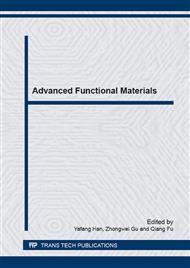p.313
p.321
p.327
p.332
p.336
p.342
p.348
p.354
p.359
Dental Resin Composites with Enhanced Properties Bycommercial Silica Particles as Fillers
Abstract:
To explore the preparation of novel dental resin composites with enhanced properties, two commercial silica particles with sizes of around 1μm and 40 nm were chosen as inorganic fillers, and firstly surface functionalized by 3-methacryloxypropyltrimethoxysilane (γ-MPS) to incorporate cross-linkable vinyl groups onto the surface of fillers. Then the modified fillers were blended with organic monomers, bisphenolAdiglycidyldimethacrylate (Bis-GMA) and triethylene glycol dimethacrylate (TEGDMA), to fabricate the resin compositeswith a three-roll mixer.Resin composites with various weight percentage of fillers and component ratio of microparticle and nanoparticle were prepared. Surface functionalization of silica particles was characterized by fourier transform infrared spectroscopy (FTIR) and thermogravimetric analysis (TGA), and mechanical properties degree of conversion, and depth of cure of the resultant resin composites were investigated byuniversal testing machineand FTIR. The results indicated that surface modification of silica particles was successful and the surface organic contents were 3.29% and 4.34%, respectively. Among the studied resin composites, the resin composite with 75 wt.% silica particles (59 wt.% microparticles and 16 wt.% nanoparticles) presented the highest value of depth of cure (5.52 ± 0.07 mm), and optimum mechanical properties such as flexural strength (149.8 ± 3.3 MPa), flexural modulus (13.8 ± 0.06 GPa), compressive strength (340.6 ± 8.3 MPa) and Vicker’smicrohardness (78.26 ± 2.45 HV). The study of dental resin composites fabricated from commercial silica particles with excellent properties might provide a new sight for realizing the preparation of this kind of dental resin composites in an industrial scale.
Info:
Periodical:
Pages:
336-341
Citation:
Online since:
March 2015
Authors:
Price:
Сopyright:
© 2015 Trans Tech Publications Ltd. All Rights Reserved
Share:
Citation:


